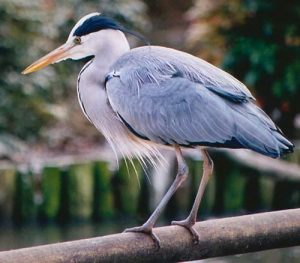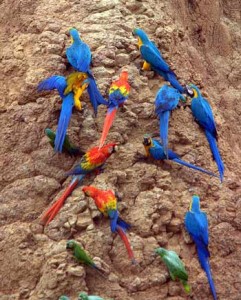
If you are into spring warblers in particular, or just the amazing migration of birds across America, most likely you are driving around Northwestern Ohio with at least one pair of binoculars. Magee Marsh and the string of wildlife areas along the western Lake Erie shores was voted the best bird watching spot in America this past year. Over 65,000 people were expected to flock to this area and be a part of the Festival of Birding — all of this just east of Toledo and down the road from my wildlife-centered farm. It is great to meet with fellow enthusiasts and be a part of everything bird — if only for a week! Birders are a great group and are willing to share their expertise as you walk the trails searching for the next elusive warbler.
Conservation Efforts
It is also a time for celebrating the 100th anniversary of the Migratory Bird Treaty that was the centerpiece that put bird conservation in motion in the United States. This treaty changed how we treated our native birds — from the unregulated killing of herons and egrets for their feathers to many thousands of wild waterfowl that were served for dinner in many cities across the country.
A number of laws were enacted that put teeth into providing refuge for our native birds. The Lacey Act, in particular, limited market hunting of wild birds such that it was illegal to kill them in one state and transport them to another state for food. President Theodore Roosevelt established the first national wildlife refuge in Florida — Pelican Island Federal Bird Reserve. He also facilitated the hiring of wardens to protect the water bird breeding areas in several states as well. We here in northwest Ohio boast the Ottawa National Wildlife refuge, which is a great spot for birding. It is historically one of the most famous resting sites as the birds fly north, allowing them a chance to rest before flying across Lake Erie and parts north on the Mississippi flyway. Other regulations followed to help protect our native gamebirds and set hunting seasons.
I think that part of the conservation movement was fueled by the loss of the passenger pigeon. John James Audubon described in 1813 what seemed to be a never-ending flock of these wonderful birds flying at about 60 miles an hour and blocking the noon day sun. He also described that it took 3 days for them to pass his site of observation. But we are never to see this glorious site. In March 1900 the last wild specimen was shot and killed with a BB gun by a boy in Sargents, Ohio. And Martha, the single passenger pigeon left of her kind, died at the Cincinnati zoo in 1914 and is stuffed and put in a glass box at the Smithsonian. It also happened with the Carolina parakeet — our natural parrot that is also no more. That should jolt all of us who love birds — it sickens me actually. This Festival of the Birds should remind us of the fragile relationship between our ecosystem and our birds. These historical losses and the pressures on current populations remind us that we need to be actively involved in saving our world, which is really their world. They are the sentinels of our future.
And that would include our parrots! While the festival centers on native species, our parrots are native in their own lands and many are in serious jeopardy. While we enjoy watching them in our homes, there is nothing like watching them in the wild just like the birders this week along the western Lake Erie shoreline. Not only do we want to name the species that we see, we want to watch their behaviors in the wild. Those basic natural behaviors often are similar between species of birds. So those wild birds on their northern migratory paths this spring provide us with a glimpse of bird behavior that provide us a window of understanding to our parrots in our homes.
Parrots: Wild and Difficult to Study

And our parrots are still wild creatures! While we have captured them and put them in cages, and with some species bred them about one generation back from the wild, parrots have retained that sense of wildness. That seems to be part of the intrigue that people have for them along with their natural beauty. Just think about what our parrots experience in our homes compared with how they have to deal with their lives in their natural wild homes. In general, our homes are much more monotonous, smaller and climate-controlled artificial environments compared with those in the wild where they originated.
Parrots in the wild have been less studied than other wild bird species in their native habitats. It seems that their natural biology is shrouded in mystery — most likely due to a number of problems in observing them. Parrots are difficult to catch and they live in remote locations high up in trees so hard to see, compared to the warblers in Magee Marsh in Ohio. Often parrots range over large areas and have been until recently difficult to track. They nest in remote areas, often in tree cavities — yet another difficulty. They are often endangered now and have far fewer numbers in their flock, making it difficult to find them and observe them in the jungle. New techniques for tagging along with GPS help us to better understand and track their whereabouts.
We recently had the honor of hearing a talk by the English author and parrot expert Rosemary Low, who has a great interest in comparing and sharing the natural behaviors of wild parrots with those in our homes. She arrived just before the start of the Festival and the biggest week here near the marshes. She also came to observe these birds in the wild and compare their behaviors with her parrots and those that she has observed in over 27 countries since 1974. I would like to share some of her experiences in the next article and things that we discussed to help our parrots in captivity lead more fulfilling lives. We had a great time and learned more about natural behaviors of birds, whether they be parrots or the migrating warblers and other song birds resting before another flight north. And it just reminds us again that we are all in this together.
For more information, see the website Biggest Week In American Birding.





